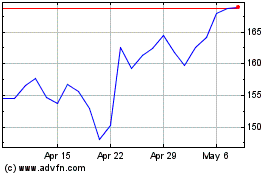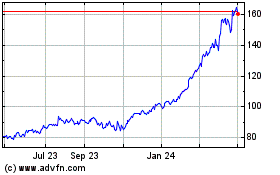By Joseph De Avila
General Electric Co.'s planned move to Boston and warnings from
bond-ratings firms have injected new urgency into discussions about
the best way to overhaul Connecticut's pension system.
The state has funded 39% of its obligations to provide
retirements for the state's 96,000 employees and retirees,
according to the state comptroller's office. To fully fund the
system by 2032, as required under an agreement with state-employee
unions, the state would need to more than double its $1.5 billion
annual contribution in upcoming years.
Democratic Gov. Dannel Malloy wants to make the pension payments
easier to handle by stretching them out over a longer period of
time and by splitting the pension fund into two accounts. His
proposal has raised concerns from the state comptroller and
treasurer's offices as well as bond-rating firms.
Now officials from AFSCME Council 4, the state's largest
public-sector union, have joined a growing number of skeptics of
the governor's idea.
"I think there are better ways of dealing with it," said
Salvatore Luciano, executive director of AFSCME Council 4.
Mr. Luciano said he preferred State Comptroller Kevin Lembo's
alternative proposal to strengthen the pension system, which
doesn't split the fund into two.
Neither approach would change what union members would receive
when they retire, and neither adds or cuts pension benefits.
Connecticut is one of several states struggling to cover their
financial obligations to retirees, including New Jersey, where Gov.
Chris Christie and Democrats have locked horns over how to address
a pension system that is underfunded by at least $37 billion.
GE's impending move from its suburban office campus in
Fairfield, Conn., has heightened the business community's concerns
about Connecticut's economic competitiveness. They say increasing
pension costs borne by the state government could trigger tax
increases that could scare off companies in the state or those
looking to relocate--just like GE.
Moody's Investors Service issued a statement on Jan. 21
following GE's announcement saying the state's pension and retiree
health care costs would continue to put pressure on the budget.
Any change to the Connecticut system is subject to negotiation
with the State Employees Bargaining Agent Coalition, which
represents 15 public-sector unions, including Council 4.
Daniel Livingston, the chief negotiator for SEBAC, said he
hasn't taken on a position on either Mr. Malloy or Mr. Lembo's
proposal. The state legislature also would need to approve the
changes.
Both Mr. Malloy and Mr. Lembo want to change how the state pays
down its pension obligations from backloading the payments--with
the costs increasing in later years--to front-loading them.
Such a shift would mean higher payments in the near term rather
the long term, a change SEBAC has long recommended and still
supports. Both the Malloy administration and the comptroller's
office say the state's annual payments also would be more
predictable.
Clouding certainty on how much the annual pension payment could
be under any overhaul scenario is how much the state receives on
its return on investing the money.
The state's pension agreement now assumes an 8% return. Boston
College published a report commissioned by the Malloy
administration that characterized the 8% rate as too optimistic. It
said the return has averaged 5.5% over the past 15 years. If that
rate continues, the administration estimates the state could pay as
much as $6.65 billion in 2032 toward pensions.
But Mr. Lembo says that assumption was too pessimistic, and he
calls for lowering the assumed rate of return to 7% from 8%. That
means the state's pension payment could rise to $3.8 billion in
2032--still more than the state can afford, he said.
Under Mr. Malloy's proposals, one pension fund would cover
employees and retirees hired before July 1, 1984, who account for
72% of the system's $14.9 billion unfunded liabilities. This fund
would be a so-called pay-as-you-go plan: The state would make
dedicated annual payments from its operating budget to pay for the
benefits but no longer invest the contributions.
A separate fund would cover workers and retirees hired on or
after July 1, 1984. Benefits for these workers would be almost
entirely paid for using the state employee pension fund's current
assets of $10.6 billion which would continue being invested.
Under the Malloy plan, annual pension payments would be more
affordable because the state would pay smaller annual pension
payments but over a longer period. Also, the Malloy administration
proposes replacing the schedule to fully fund the system by 2032
with a rolling period--with no set end date.
Mr. Lembo opposes the pay-as-you-go approach, saying it risks
placing the annual payment at the mercy of sometimes contentious
budget debates at the capital.
Mr. Lembo said it was unclear if Mr. Malloy's approach to split
up the system would be legal. He added that bond-ratings firm
Standard & Poor's said in November that it could downgrade the
Connecticut's bond rating if the state adopts that plan, with the
firm saying it would represent a "significant deferral of unfunded
pension liabilities after fiscal 2018."
In response to Standard & Poor's warning, a spokesman for
the Malloy administration's budget office said its proposal would
improve the state's long-term fiscal stability and would save the
state billions of dollars.
As with Mr. Malloy's proposal, Mr. Lembo's approach would give
the state more time to make good on its pension obligations.
Liabilities accrued before 1983 and before would stay on their
current schedule and be fully funded by 2032. The liabilities
accrued in 1984 and after would be paid off under a new schedule
with a 25-year deadline.
Write to Joseph De Avila at joseph.deavila@wsj.com
(END) Dow Jones Newswires
January 29, 2016 19:43 ET (00:43 GMT)
Copyright (c) 2016 Dow Jones & Company, Inc.
GE Aerospace (NYSE:GE)
Historical Stock Chart
From Mar 2024 to Apr 2024

GE Aerospace (NYSE:GE)
Historical Stock Chart
From Apr 2023 to Apr 2024
